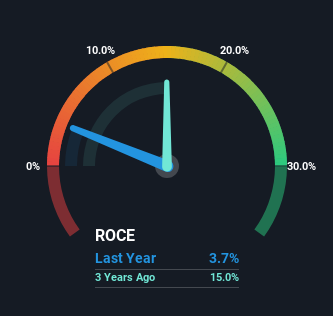- China
- /
- Semiconductors
- /
- SHSE:603396
Yingkou Jinchen Machinery (SHSE:603396) Could Be Struggling To Allocate Capital
What are the early trends we should look for to identify a stock that could multiply in value over the long term? Typically, we'll want to notice a trend of growing return on capital employed (ROCE) and alongside that, an expanding base of capital employed. Ultimately, this demonstrates that it's a business that is reinvesting profits at increasing rates of return. However, after investigating Yingkou Jinchen Machinery (SHSE:603396), we don't think it's current trends fit the mold of a multi-bagger.
Understanding Return On Capital Employed (ROCE)
Just to clarify if you're unsure, ROCE is a metric for evaluating how much pre-tax income (in percentage terms) a company earns on the capital invested in its business. Analysts use this formula to calculate it for Yingkou Jinchen Machinery:
Return on Capital Employed = Earnings Before Interest and Tax (EBIT) ÷ (Total Assets - Current Liabilities)
0.037 = CN¥100m ÷ (CN¥6.4b - CN¥3.6b) (Based on the trailing twelve months to March 2024).
Therefore, Yingkou Jinchen Machinery has an ROCE of 3.7%. On its own that's a low return on capital but it's in line with the industry's average returns of 3.9%.
Check out our latest analysis for Yingkou Jinchen Machinery

While the past is not representative of the future, it can be helpful to know how a company has performed historically, which is why we have this chart above. If you'd like to look at how Yingkou Jinchen Machinery has performed in the past in other metrics, you can view this free graph of Yingkou Jinchen Machinery's past earnings, revenue and cash flow.
What Can We Tell From Yingkou Jinchen Machinery's ROCE Trend?
The trend of ROCE doesn't look fantastic because it's fallen from 11% five years ago, while the business's capital employed increased by 196%. However, some of the increase in capital employed could be attributed to the recent capital raising that's been completed prior to their latest reporting period, so keep that in mind when looking at the ROCE decrease. The funds raised likely haven't been put to work yet so it's worth watching what happens in the future with Yingkou Jinchen Machinery's earnings and if they change as a result from the capital raise.
Another thing to note, Yingkou Jinchen Machinery has a high ratio of current liabilities to total assets of 57%. This can bring about some risks because the company is basically operating with a rather large reliance on its suppliers or other sorts of short-term creditors. While it's not necessarily a bad thing, it can be beneficial if this ratio is lower.
In Conclusion...
While returns have fallen for Yingkou Jinchen Machinery in recent times, we're encouraged to see that sales are growing and that the business is reinvesting in its operations. Furthermore the stock has climbed 61% over the last five years, it would appear that investors are upbeat about the future. So while investors seem to be recognizing these promising trends, we would look further into this stock to make sure the other metrics justify the positive view.
One more thing to note, we've identified 1 warning sign with Yingkou Jinchen Machinery and understanding it should be part of your investment process.
For those who like to invest in solid companies, check out this free list of companies with solid balance sheets and high returns on equity.
New: Manage All Your Stock Portfolios in One Place
We've created the ultimate portfolio companion for stock investors, and it's free.
• Connect an unlimited number of Portfolios and see your total in one currency
• Be alerted to new Warning Signs or Risks via email or mobile
• Track the Fair Value of your stocks
Have feedback on this article? Concerned about the content? Get in touch with us directly. Alternatively, email editorial-team (at) simplywallst.com.
This article by Simply Wall St is general in nature. We provide commentary based on historical data and analyst forecasts only using an unbiased methodology and our articles are not intended to be financial advice. It does not constitute a recommendation to buy or sell any stock, and does not take account of your objectives, or your financial situation. We aim to bring you long-term focused analysis driven by fundamental data. Note that our analysis may not factor in the latest price-sensitive company announcements or qualitative material. Simply Wall St has no position in any stocks mentioned.
Have feedback on this article? Concerned about the content? Get in touch with us directly. Alternatively, email editorial-team@simplywallst.com
About SHSE:603396
Yingkou Jinchen Machinery
Focuses on vacuum coating technology, automation technology, and equipment intelligent solutions internationally.
Excellent balance sheet second-rate dividend payer.
Market Insights
Community Narratives



